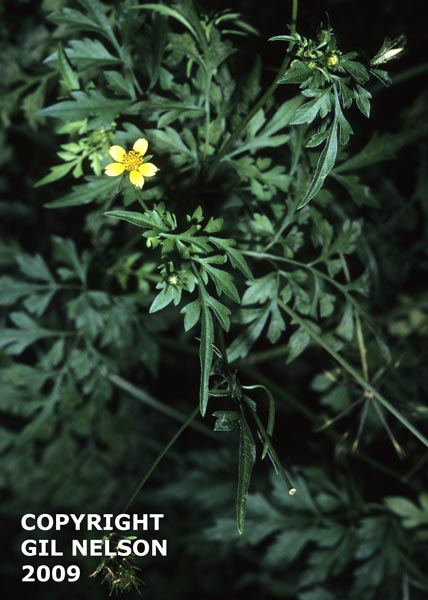Difference between revisions of "Bidens bipinnata"
(→Ecology) |
(→Pollination and use by animals) |
||
| Line 47: | Line 47: | ||
===Pollination and use by animals=== | ===Pollination and use by animals=== | ||
| − | + | ''Bidens bipinnataby'' is pollinated by Honeybees, leaf-cutting bees (''Megachile'' spp., ''Coelioxys sayi, Heriades leavitti''), and the butterfly ''Pieris rapae.''<ref name="illinois"/> Additionally, this species has been observed to host pollinators in the Andrenidae family such as ''Andrena aliciae'' and ''Pseudopanurgus rugosus'', ''Lasioglossum pilosum'' (family Halictidae), as well as insects from the family Membracidae ''Acutalis tartarea'' and ''Entylia carinata''.<ref>Discoverlife.org [https://www.discoverlife.org/20/q?search=Bidens+albaDiscoverlife.org|Discoverlife.org]</ref> | |
Caterpillars of moths ''Cirrhophanus triangulifer, Condica confederata, Epiblema otiosana, Palthis asopialis, Platysenta mobilis,'' and ''Synchlora aerata'' feed on the foliage. Leaf beetles ''Calligrapha bidenticola'' and ''Calligrapha californica'' feed on the leaves. The aphid ''Aphis coreopsidis'' sucks juices from the flowering stalks. Seeds are eaten by birds such as the Ring-Necked Pheasant, Bobwhite, Wood Duck, Purple Finch, and Common Redpoll. The foliage is eaten by the cottontail rabbit.<ref name="illinois">[[(http://www.illinoiswildflowers.info/weeds/plants/spanish_needles.htm]]Illinois Wildflowers. Accessed: April 4, 2016</ref> | Caterpillars of moths ''Cirrhophanus triangulifer, Condica confederata, Epiblema otiosana, Palthis asopialis, Platysenta mobilis,'' and ''Synchlora aerata'' feed on the foliage. Leaf beetles ''Calligrapha bidenticola'' and ''Calligrapha californica'' feed on the leaves. The aphid ''Aphis coreopsidis'' sucks juices from the flowering stalks. Seeds are eaten by birds such as the Ring-Necked Pheasant, Bobwhite, Wood Duck, Purple Finch, and Common Redpoll. The foliage is eaten by the cottontail rabbit.<ref name="illinois">[[(http://www.illinoiswildflowers.info/weeds/plants/spanish_needles.htm]]Illinois Wildflowers. Accessed: April 4, 2016</ref> | ||
<!--===Diseases and parasites===--> | <!--===Diseases and parasites===--> | ||
Revision as of 19:27, 10 June 2021
| Bidens bipinnata | |
|---|---|

| |
| photo by Gil Nelson | |
| Scientific classification | |
| Kingdom: | Plantae |
| Division: | Magnoliophyta - Flowering plants |
| Class: | Magnoliopsida - Dicotyledons |
| Order: | Asterales |
| Family: | Asteraceae ⁄ Compositae |
| Genus: | Bidens |
| Species: | B. bipinnata |
| Binomial name | |
| Bidens bipinnata L. | |

| |
| Natural range of Bidens bipinnata from USDA NRCS Plants Database. | |
Common name: Spanish needles
Contents
Taxonomic notes
Synonyms: none.[1]
Varieties: none.[1]
Description
A description of Bidens bipinnata is provided in The Flora of North America.
B. bipinnata is an annual herb. It tends to be a ruderal, weedy species.[2]
Distribution
Ecology
Habitat
B. bipinnata is found in marsh and island communities, river bluffs, and pine-oak woodlands. It has also been found in disturbed areas including campgrounds, roadsides, ditches, disturbed coastal hammocks, old fields, and fire line. This species prefers shaded environments and moist sandy soil types like sandy loam, red sandy clay, and loamy sand.[2] It does not respond to soil disturbance by clearcutting and chopping in North Florida flatwoods forests.[3]
Associated species includes Quercus geminata, Desmodium ochroleucum, D. rotundifolium, Pinus, other Quercus's, Cornus florida, Liquidambar styraciflua, and others.[2]
Phenology
This species has been observed flowering and fruiting from July to October.[2][4]
Seed dispersal
The barbed awns of the seeds allow for the seed to attach to animals and humans and be dispersed far distances.[5]
Fire ecology
B. bipinnata is a seeder; 70% mortality when subjected to 100% leaf scorch[6]. It is fire tolerant and frequent in firebreaks.[2]
Pollination and use by animals
Bidens bipinnataby is pollinated by Honeybees, leaf-cutting bees (Megachile spp., Coelioxys sayi, Heriades leavitti), and the butterfly Pieris rapae.[5] Additionally, this species has been observed to host pollinators in the Andrenidae family such as Andrena aliciae and Pseudopanurgus rugosus, Lasioglossum pilosum (family Halictidae), as well as insects from the family Membracidae Acutalis tartarea and Entylia carinata.[7] Caterpillars of moths Cirrhophanus triangulifer, Condica confederata, Epiblema otiosana, Palthis asopialis, Platysenta mobilis, and Synchlora aerata feed on the foliage. Leaf beetles Calligrapha bidenticola and Calligrapha californica feed on the leaves. The aphid Aphis coreopsidis sucks juices from the flowering stalks. Seeds are eaten by birds such as the Ring-Necked Pheasant, Bobwhite, Wood Duck, Purple Finch, and Common Redpoll. The foliage is eaten by the cottontail rabbit.[5]
Conservation, cultivation, and restoration
Cultivate in partial sunlight, moist to mesic conditions with fertile loamy soil.[5]
Cultural use
Photo Gallery
References and notes
- ↑ 1.0 1.1 Weakley, A.S. 2015. Flora of the southern and mid-atlantic states. Working Draft of 21 May 2015. University of North Carolina at Chapel Hill, Chapel Hill, North Carolina.
- ↑ 2.0 2.1 2.2 2.3 2.4 Florida State University Robert K. Godfrey Herbarium database. URL: http://herbarium.bio.fsu.edu. Last accessed: June 2014. Collectors: Bian Tan, Loran C. Anderson, Ed Keppner, Lisa Keppner, Richard S. Mitchell, R.K. Godfrey, R. Kral, Wilson Baker, R. Komarek, Andre F. Clewell, R.A. Norris, and Andre F. Clewell. States and Counties: Florida: Columbia, Wakulla, Bay, Calhoun, Leon, Franklin, Jackson, Jefferson, and Liberty. Georgia: Grady.
- ↑ Moore, W.H., B.F. Swindel, and W.S. Terry. (1982). Vegetative Response to Clearcutting and Chopping in a North Florida Flatwoods Forest. Journal of Range Management 35(2):214-218.
- ↑ Nelson, G. PanFlora: Plant data for the eastern United States with emphasis on the Southeastern Coastal Plains, Florida, and the Florida Panhandle. www.gilnelson.com/PanFlora/ Accessed: 19 MAY 2021
- ↑ 5.0 5.1 5.2 5.3 (http://www.illinoiswildflowers.info/weeds/plants/spanish_needles.htmIllinois Wildflowers. Accessed: April 4, 2016
- ↑ []Fire Manager. Accessed: April 4, 2016
- ↑ Discoverlife.org [1]